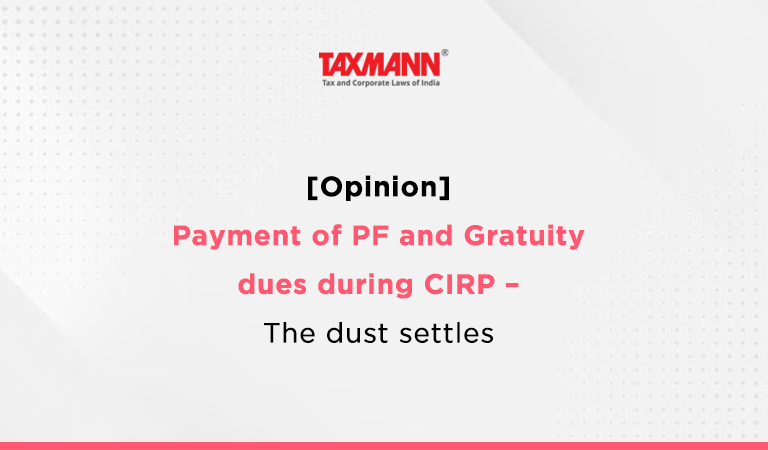[Opinion] Payment of PF and Gratuity dues during CIRP – The dust settles
- Blog|News|Insolvency and Bankruptcy Code|
- 3 Min Read
- By Taxmann
- |
- Last Updated on 24 February, 2023

[2023] 147 taxmann.com 422 (Article)
Introduction
The Insolvency and Bankruptcy Code (IBC) is a comprehensive law in India that aims to simplify and expedite the insolvency and bankruptcy proceedings in the country. It consolidates and amends all the existing insolvency laws to promote entrepreneurship, maximise the value of corporate debtor and help struggling companies to turnaround.
One of the stakeholders in a company that the IBC aims to protect are the workmen and employees. However, the IBC is silent on the treatment of various components of the salary and wages of employees and workmen and does not provide much guidance on how provident fund and gratuity dues should be treated during Corporate Insolvency Resolution Process (CIRP) under IBC. The EPF Act was created to promote social security for employees in companies, with the objective of following the Directive Principles of State Policy outlined in articles 38 and 43 of the Indian Constitution.
The EPF & MP Act includes provisions to safeguard the interests of employees when their employers fail to make mandatory contributions. However, when a company is undergoing a CIRP under the IBC, the priority of EPF dues takes on a different significance. This means that while the EPF & MP Act is designed to protect employee rights, its application during a company’s insolvency proceedings can be complicated.
The Employees & Provident Funds and Miscellaneous Provisions Act, 1952, provides for the establishment of a provident fund, pension fund, and deposit-linked insurance fund for the benefit of employees. The Act makes it mandatory for employers and employees to contribute to the provident fund, and the contribution rates are fixed by the Central Government from time to time. The Act also provides for the constitution of the Central Board of Trustees, which is responsible for the overall management and administration of the funds.
Exclusion of Provident fund and Gratuity from Liquidation State
Section 36 of the Insolvency and Bankruptcy Code (IBC) contains provisions that exclude certain assets from the liquidation estate, and therefore these assets cannot be used for recovery in the liquidation process. One important exclusion mentioned in this section relates to the outstanding amounts owed to workers or employees, specifically those amounts related to their provident fund, pension fund, and gratuity fund. Section 36(4)(a)(iii) specifically states that all sums due to any workman or employee from the provident fund, the pension fund and the gratuity fund shall not be included in the liquidation estate assets and shall not be used for recovery in the liquidation.
This implies that any money that an employer owes to its employees as part of these funds cannot be used to recover the debts owed by the employer during the liquidation process. The amount that an employer is obligated to pay into these funds is meant to be a safeguard for the employees’ future, and as such, it is considered sacrosanct and protected from the effects of liquidation. It’s important to note that Section 36 of the IBC provides several other exclusions as well, which must be carefully considered during the liquidation process. However, the exclusion of amounts owed to employees from these specific funds is an important one that ensures that workers’ hard-earned savings are not put at risk during the insolvency proceedings of their employer.
In the case of State Bank of India v. Moser Baer Karamchari Union [2019] 108 taxmann.com 251 (NCL – AT) the question of whether provident fund, pension fund, and gratuity fund dues could be included in section 53 of the Insolvency and Bankruptcy Code, 2016 (IBC) was considered. The Adjudicating Authority allowed the application on the grounds that these dues could not be part of Section 53 of the IBC. The case related to a liquidation proceeding, and the Adjudicating Authority directed the Liquidator to make payments for provident fund, pension fund, and gratuity fund in accordance with Section 36(4)(a)(iii) of the IBC. The National Company Law Appellate Tribunal (NCLAT) upheld the decision of the Adjudicating Authority, which held that provident fund, pension fund, and gratuity fund do not come within the meaning of liquidation estate. This means that these funds are not part of the assets available for distribution to the creditors of the company in liquidation.
Click Here To Read The Full Article
Disclaimer: The content/information published on the website is only for general information of the user and shall not be construed as legal advice. While the Taxmann has exercised reasonable efforts to ensure the veracity of information/content published, Taxmann shall be under no liability in any manner whatsoever for incorrect information, if any.

Taxmann Publications has a dedicated in-house Research & Editorial Team. This team consists of a team of Chartered Accountants, Company Secretaries, and Lawyers. This team works under the guidance and supervision of editor-in-chief Mr Rakesh Bhargava.
The Research and Editorial Team is responsible for developing reliable and accurate content for the readers. The team follows the six-sigma approach to achieve the benchmark of zero error in its publications and research platforms. The team ensures that the following publication guidelines are thoroughly followed while developing the content:
- The statutory material is obtained only from the authorized and reliable sources
- All the latest developments in the judicial and legislative fields are covered
- Prepare the analytical write-ups on current, controversial, and important issues to help the readers to understand the concept and its implications
- Every content published by Taxmann is complete, accurate and lucid
- All evidence-based statements are supported with proper reference to Section, Circular No., Notification No. or citations
- The golden rules of grammar, style and consistency are thoroughly followed
- Font and size that’s easy to read and remain consistent across all imprint and digital publications are applied





